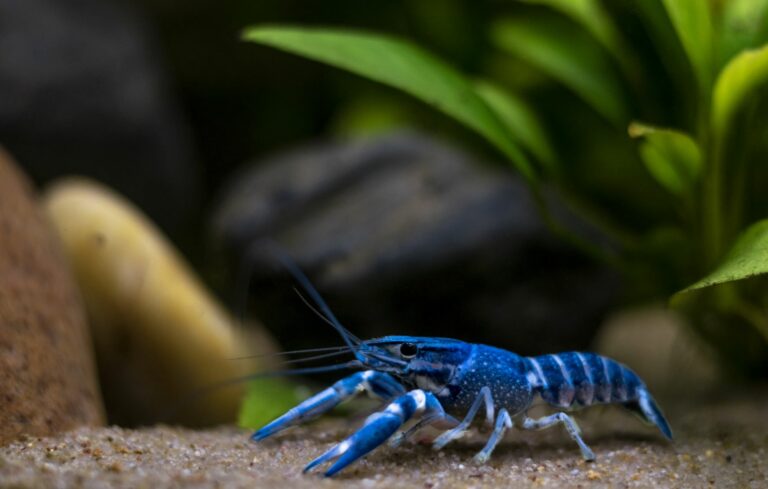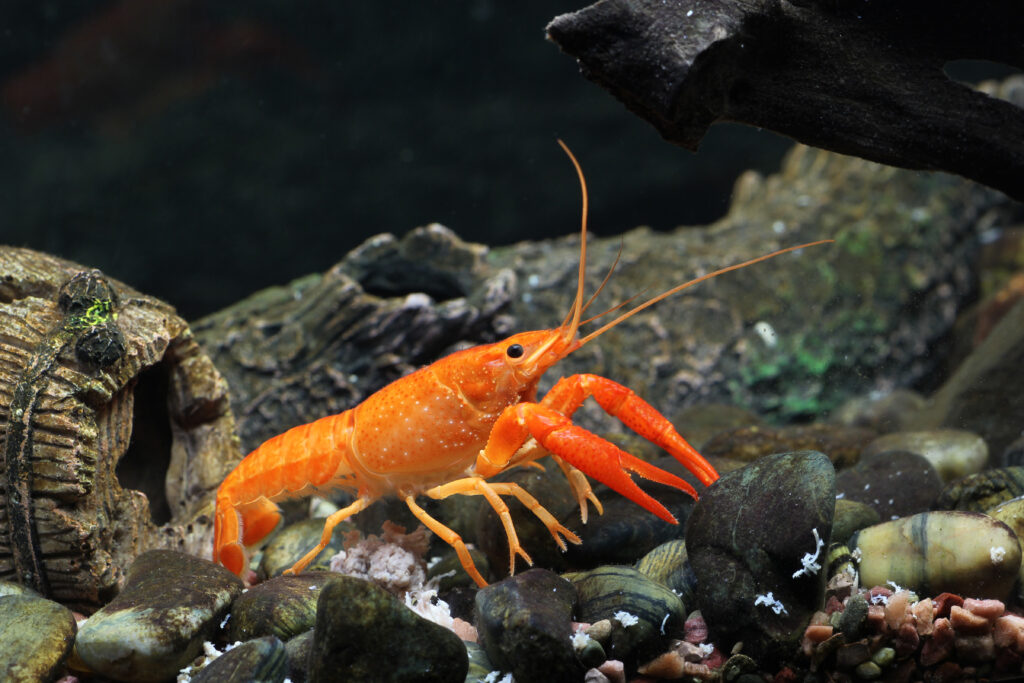Butterfly Koi
Are you looking for new carps (Cyprinus carpio) for your pond? Then you should definitely consider the Butterfly Koi. Read in this article the most important information on this beautiful Koi.
The European Noble Crayfish (Astacus astacus) from the family of freshwater crayfish (Astacidae) is a native species that originally lives in streams, rivers, and lakes. Unfortunately, the noble crayfish is now rarely found in the wild. In your garden pond, you can offer this impressive crayfish an alternative habitat. Learn more here about keeping and caring for noble crayfish in your garden pond.

© Pantherius / stock.adobe.com
Noble crayfish can adapt their colour based on their environment
Measured from head to tail, it can reach a body length of 20cm and a body weight of up to 350g. On its head, it has two pairs of antennae and two eye ridges around its eyes (postorbital ridges). The noble crayfish has two claws, which are used for holding prey and for defence.
Its colouration is usually reddish-brown to dark brown – very rarely blue. IT can also adapt their colour somewhat to their environment. The undersides of the claws and the joints are deep red. This is the main distinguishing feature from other crayfish species.
Noble crayfish males can be easily distinguished from females. Generally, the females are smaller and have smaller claws. The reliable characteristic for determining gender is the gonopods. To observe this, look at the underbody of the crayfish. The males have v-shaped mating appendages (first two pairs of swimmerets are modified).
Instead, females have two small openings at the base of their second pair of walking legs. Under the abdomen of the females, you can see five swimmerets, while males have three.
The European noble crayfish is native to almost all of Europe, except Ireland, northern England, and the Iberian Peninsula. Before the 20th century, the noble crayfish could still be found in many rivers and streams in its natural habitat. While it was a regular item on everyday menus back then, today it is considered a delicacy among gourmets. The European Noble Crayfish was almost eradicated in Germany by the crayfish plague. The host and spreader of the plague pathogen is the American signal crayfish, which was imported into Europe at the beginning of the 20th century. It is resistant to the pathogen itself.
Due to the crayfish plague, these two crayfish species should not be kept together in a garden pond or aquarium. Even using the same water can spread the plague.
The Noble Crayfish is a peaceful, well-natured companion. It becomes active only at dusk and likes to hide during the day in the shore area – tucked away under plants, stones, and roots. It is possible to socialise it with fish, provided they inhabit different areas of the garden pond.
It prefers to collect their food from the pond floor; however, it is not impossible for a small pond dweller to end up in its claw. But it is mostly the delicate young crayfish that could be easy prey for fish. Stocking with different crayfish species is not possible.
The Noble Crayfish breathes through gills but can survive for several hours on land. If Astacus astacus does not like the water body, it will migrate and find a new habitat.
 © fieryphoenix / stock.adobe.com
© fieryphoenix / stock.adobe.com
Noble Crayfish live between 15 and 20 years in the wild. In an aquarium, their lifespan is significantly shorter. They become sexually mature at three years old.
Once a year in October, when temperatures cool, it’s mating season. During mating, the male attaches small, white, stick-shaped sperm packets to the female’s underside. The female then begins laying up to 400 eggs, which she carries under her curled tail for approx. 26 weeks.
Between May and June, the fully developed larvae hatch. The young crayfish (summerlings) are almost transparent and stay with their mother until the first moulting, about ten days later. In the first year, the young noble crayfish moult up to ten times. In the second year, there are four to five moults, and in the third year, two to three. Ultimately, only approx. 10% to 20% of the eggs develop into young crayfish.
Adult noble crayfish are generally solitary and do not necessarily need a partner.
If you wish to stock your garden pond with noble crayfish, read here about the requirements needed for their habitat. Your pond should have a depth of at least 1m to allow the crayfish to overwinter comfortably. The noble crayfish needs water that reaches a minimum temperature of 15°C in summer, as this is when the sexual organs develop. Temperatures above 25°C should be avoided. In winter, the temperature should not fall below 4°C. The pH value should be between 6 and 9, and the oxygen content should be 5.5 milligrams per litre. The noble crayfish is highly sensitive to water pollution from pesticides and insecticides.
Additionally, the noble crayfish loves and needs caves made from large stones, roots or similar where it can retreat and be protected during the day. To provide a suitable habitat, it also needs stable, diggable shorelines and a spacious shore area where it can dig extensively.
When it comes to feeding, the noble crayfish is not particularly demanding or picky. It is omnivorous, primarily feeding on organic remains: from dead fish, worms, snails, and insects to dead plant parts like fallen leaves, plant remains, and algae – as long as it’s varied.
Because they clean the water of organic waste, their presence ensures especially good water quality in the garden pond. Therefore, the noble crayfish is often referred to as the health police of the garden pond.
Usually, you do not need to feed them separately. If you want to offer a special treat now and then, fresh vegetables, common crayfish food or even pieces of fish fillet are suitable.
The noble crayfish is threatened with extinction in the wild. By deciding to stock noble crayfish in your garden pond, you are contributing to the conservation of these impressive animals. As a native crayfish species, the noble crayfish adapts relatively easily to the garden pond habitat. The young crayfish, in particular, can easily adjust to the new conditions in your pond. They are also still too small to migrate, which gives you plenty of time to create optimal living conditions for the new pond residents. We wish you lots of fun and delight with them.
Are you looking for new carps (Cyprinus carpio) for your pond? Then you should definitely consider the Butterfly Koi. Read in this article the most important information on this beautiful Koi.
Guppies (Poecilia reticulata) are among the most popular fish for freshwater aquariums worldwide. They breed easily even in captivity, are easy to care for, and thus are well-suited for beginners in aquaristics. Guppies are colourful and forgiving of small mistakes. These active animals come in many varieties.
Radiantly colourful and somewhat aggressive towards other fish and conspecifics: The Siamese Fighting Fish is a remarkable creature that brings a dash of colour to any aquarium. With modest demands, this pet is incredibly easy to care for and very popular with aquaristics beginners. This article compiles the most important information about the Siamese Fighting Fish.